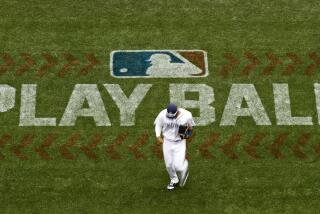Another Called Strike
The director of the baseball players union tried to reassure Americans the other day by saying the players had no strike set for Sept. 16. Aww, why not? How about Sept. 4? Or tomorrow?
Let’s take all the petulant millionaire players and all the cantankerous millionaire owners by their ears and put them in separate corners. Let’s give them a timeout and make them face the wall and what they’re doing to a once-grand game that used to seem like America’s pastime. Now it’s more like passed time. Did either side grasp the lessons, the drooped attendance and the distaste lingering from 1994’s 232-day strike?
It’s one thing to put up with the five or 10 seconds of excitement between long bouts of spitting, tapping, glove-tightening and idle swinging. But today, we’ve got 850 active players making, on average, $2,345,920 a year. Poor babies, that’s only about $14,481 a game for one “year” of “work”--staying in peak shape and dashing around carefully raked dirt, hitting or chasing a little ball for maybe eight months. After running 90 feet they need a break to brush off any dirt. That salary is more money per year than most of us will make for a lifetime of real work.
Donald Fehr, the union executive, is racking up frequent-flier miles these days briefing players on all 30 teams on the status of negotiations with owners. They don’t want to be striking on the anniversary of Sept. 11, which shows how sensitive they are, see?
How about collecting fan feedback? Ask fans whether they might strike both sides in baseball. Ask parents whether they still share baseball stories with their children to teach real-life lessons about education, grit and comebacks. Do they count days till the World Series ritual? How do parents answer wide-eyed questions about heroes using drugs or being asked to drop by the police station? Also check how many afternoons at the old ballpark the average family can afford these pricey days. Besides ATMs, these parks will soon need loan officers to finance snacks.
Yes, this is a business for both sides. Players seek more; owners pay it. Then they cry poverty. They market themselves as the key element of the game, as fantasy, as entertainment. Then they act like real pirates. Sure, the issues are thorny. Handle them. With so much mistrust polluting our business and political atmospheres, it’s incumbent on these folks to work it out, take one for the national team.
By the way, did either side notice the average per-game attendance after 1,467 games this year? It was down 1,533 fans to 28,281. That’s a 5% drop. Hmmm, any lesson there? Other than the obvious one: Increase prices again.
More to Read
Go beyond the scoreboard
Get the latest on L.A.'s teams in the daily Sports Report newsletter.
You may occasionally receive promotional content from the Los Angeles Times.










